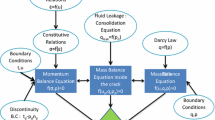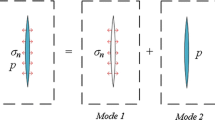Abstract
Material anisotropy may significantly influence the behavior of fluid transport in sedimentary basins and other environments with laminated or foliated rocks. In this paper, we present a fracture mechanics model to investigate primary migration of petroleum (oil and gas) through propagation of a vertical, buoyancy-driven blade crack in a transversely isotropic source rock. The source rock is assumed to have very low permeability and hence can be modeled as a linear elastic medium. Fracture parameters (stress intensity factor and crack opening displacement) are derived using an equivalent set of anisotropic elastic properties. The crack propagation velocity (i.e., petroleum migration velocity) and crack opening (fracture aperture) are determined using a fracture mechanics criterion together with the first order approximation of plane Poiseuille flow equations of fluid mechanics. For subhorizontal layering, we find that the fluid migration velocity and fracture aperture are significantly increased if the elastic modulus in the vertical direction is smaller than that in the horizontal direction. Finally, we discuss the applicability of the formula for isotropic materials along with the equivalent anisotropic elastic parameters introduced in this paper to evaluate fracture aperture for cracks in anisotropic rocks.









Similar content being viewed by others
References
Amadei B, Pan E (1992) Gravitational stresses in anisotropic rock masses with inclined strata. Int J Rock Mech Min Sci Geomech Abstr 29:225–236
Bai T, Pollard DD (2001) Getting more for less: the unusual efficiency of fluid flow in fractures. Geophys Res Lett 28:65–68
Bayuk IO, Ammerman M, Chesnokov EM (2008) Upscaling of elastic properties of anisotropic sedimentary rocks. Geophys J Int 172:842–860
Chen CS, Pan E, Amedei B (1998) Fracture mechanics analysis of cracked discs of anisotropic rock using the boundary element method. Int J Rock Mech Min Sci Geomech Abstr 35:195–218
Chen Z, Jin ZH, Johnson SE (2007) A perturbation solution for dyke propagation in an elastic medium with graded density. Geophys J Int 169:348–356
Comer JB, Hinch HH (1987) Recognizing and quantifying expulsion of oil from the Woodford Formation and age-equivalent rocks in Oklahoma and Arkansas. AAPG Bull 71:844–858
Dahm T (2000a) Numerical simulations of the propagation path and the arrest of fluid-filled fractures in the earth. Geophys J Int 141:623–638
Dahm T (2000b) On the shape and velocity of fluid-filled fractures in the earth. Geophys J Int 142:181–192
Dou HS, Khoo BC (2011) Investigation of turbulent transition in plane Couette flows using energy gradient method. Adv Appl Math Mech 3:165–180
Duan ZH, Moller N, Weare JN (1992) An equation of state for the CH4–CO2–H2O system: I. Pure systems from 0 to 1000 °C and 0 to 8000 bar. Geochim Cosmochim Acta 56:2605–2617
England WA, MacKenzie AS, Mann DM, Quigley TM (1987) The movement and entrapment of petroleum fluids in the subsurface. J Geol Soc Lond 144:327–347
Hunt JM (1990) Generation and migration of petroleum from abnormally pressured fluid compartments. AAPG Bull 74:1–12
Hunt JM (1996) Petroleum geochemistry and geology, 2nd edn. Freeman, San Francisco
Jin ZH, Johnson SE (2008) Primary oil migration through buoyancy-driven multiple fracture propagation: oil velocity and flux. Geophys Res Lett 35:L09303
Jin ZH, Mai YW (1997) Residual strength of an ARALL laminate containing a crack. J Compos Mater 31:746–761
Jin ZH, Johnson SE, Cook AE (2015) Crack extension induced by dissociation of fracture-hosted methane gas hydrate. Geophys Res Lett 42:8522–8529
Krenk S (1979) On the elastic constants of plane orthotropic elasticity. J Compos Mater 13:108–116
Lash GG, Engelder T (2005) An analysis of horizontal microcracking during catagenesis: an example from the Catskill delta complex. AAPG Bull 89:1433–1449
Law BE, Spencer CW (1998) Abnormal pressure in hydrocarbon environments. In: Law BE, Ulmishek GF, Slavin VI (eds) Abnormal pressures in hydrocarbon environments: AAPG memoir 70. American Association of Petroleum Geologists, Tulsa, pp 1–11
Lister JR (1991) Steady solutions for feeder dykes in a density-stratified lithosphere. Earth Planet Sci Lett 107:233–242
Lister JR, Kerr RC (1991) Fluid-mechanical models of crack propagation and their application to magma transport in dykes. J Geophys Res 96:10049–10077
Mann U (1990) Sedimentological and petrophysical aspects of primary petroleum migration pathways. In: Förstner U, Heling D, Koch R, Rothe P, Stoffers P (eds) Sediments and environmental geochemistry—selected aspects and case histories. Springer, Heidelberg, pp 152–178
Miller TW (1995) New insights on natural hydraulic fractures induced by abnormally high pore pressure. AAPG Bull 79:1005–1018
Nakashima Y (1993) Buoyancy-driven propagation of an isolated fluid-filled crack in rock: implication for fluid transport in metamorphism. Contrib Miner Petrol 114:289–295
Nelson RA (2001) Geological analysis of naturally fractured reservoirs, 2nd edn. Gulf Professional Publishing, Butterworth-Heinemann, Boston
Nihei KT, Nakagawa S, Reverdy F, Myer LR, Duranti L, Ball G (2011) Phased array compaction cell for measurement of the transversely isotropic elastic properties of compacting sediments. Geophysics 76:WA113–WA123
Nunn JA (1996) Buoyancy-driven propagation of isolated fluid-filled fractures—implications for fluid transport in Gulf of Mexico geopressured sediments. J Geophys Res 101:2963–2970
Nunn JA, Meulbroek P (2002) Kilometer-scale upward migration of hydrocarbon in geopressured sediments by buoyancy-driven propagation of methane-filled fractures. AAPG Bull 85:907–918
Palciauskas VV, Domenico PA (1980) Microfracture development in compacting sediments: relations to hydrocarbon maturation kinetics. AAPG Bull 64:927–937
Pan E (1997) A general boundary element analysis of 2-D linear elastic fracture mechanics. Int J Fract 88:41–59
Pan E, Amadei B (1996) Fracture mechanics analysis of 2-D cracked anisotropic media with a new formulation of the boundary element method. Int J Fract 77:161–174
Pan E, Chen W (2015) Static green’s functions in anisotropic media. Cambridge University Press, Cambridge
Pan E, Yuan FG (2000) Boundary element analysis of three-dimensional cracks in anisotropic solids. Int J Numer Methods Eng 48:211–237
Pan PZ, Rutqvist J, Feng XT, Yan F (2014) TOUGH-RDCA modeling of multiple fracture interactions in caprock during CO2 injection into a deep brine aquifer. Comput Geosci 65:24–36
Roper SM, Lister JR (2007) Buoyancy-driven crack propagation: the limit of large fracture toughness. J Fluid Mech 580:359–380
Rubin AM (1995) Propagation of magma-filled crack. Annu Rev Earth Planet Sci 23:287–3336
Sanjari E, Lay EN, Peymani M (2011) An accurate empirical correlation for predicting natural gas viscosity. J Natl Gas Chem 20:654–658
Spence DA, Sharp PW, Turcotte DL (1987) Buoyancy-driven crack propagation: a mechanism for magma migration. J Fluid Mech 174:135–153
Weertman J (1971) Velocity at which liquid-filled cracks move in the Earth’s crust or in glaciers. J Geophys Res 76:8544–8553
Acknowledgements
This work was partly funded by NSF Grant EAR-1347087.
Author information
Authors and Affiliations
Corresponding author
Ethics declarations
Conflict of interest
The author declares that they have no conflict of interest.
Rights and permissions
About this article
Cite this article
Jin, ZH., Johnson, S.E. Effects of elastic anisotropy on primary petroleum migration through buoyancy-driven crack propagation. Geomech. Geophys. Geo-energ. Geo-resour. 3, 365–378 (2017). https://doi.org/10.1007/s40948-017-0062-6
Received:
Accepted:
Published:
Issue Date:
DOI: https://doi.org/10.1007/s40948-017-0062-6




